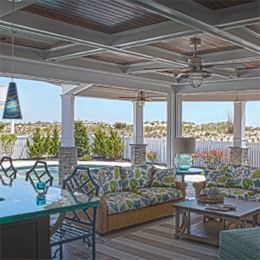
Spending a few weeks down the Shore every summer is a rite of passage for just about every family in South Jersey. Days spent building sandcastles, watching the coquina clams dig themselves back into the wet sand, fending off seagulls from your French fries and nights on the boardwalk at the arcade, riding the bumper cars again and again, or loading up on fudge and saltwater taffy. It’s the quintessential vacation—all just about an hour away from home.
And for those of you who regularly rent a home along the coast in the summer, you can likely admit to daydreaming about the future when you’d actually own a home at the Shore, walking down certain blocks, eyeing up the perfectly pastel houses so close to the beach you could taste the salt from the ocean, saying: “That one right there. That’s the one.”
Of course buying a second home is a big investment, and there are lots of factors to consider when determining if your summer rental days are behind you. To hear local realtors tell it, this is the time of year to make those dreams a reality.
“Now is the best time to look at a home at the Shore because people do not want to keep making mortgage payments for the winter and spring months. Sellers are more likely to negotiate around this time,” says Ginger O’Neill of Coldwell Banker Argus Real Estate in Ventnor City. “You might be looking at about 60 days until settlement, but once you’re in you still have plenty of time to make any changes or upgrades for the summer.”
Economic trends seem to be positive for real estate up and down the coast.
“The economy has really been improving and getting back to normal, which is creating consumer confidence, and people are making moves on properties while interest rates are low,” says R.J. Soens III, broker and sales representative for the R.J. Soens Group/Long & Foster Real Estate in Avalon. “Heading into this year we have 45 percent less for sale in Avalon/Stone Harbor manors compared to 2010. Demand has increased due to those economic factors.”
In Cape May, units coming onto the market are moving at a good pace and prices are increasing, but not at an alarming rate, according to Justin Aftanis, broker/salesperson at Cape May Realty. “It’s not a buyers’ market or a seller’s market, it’s good for both sides,” he says. “Buyers are not feeling pressured to pay full price and sellers are realistic in knowing that taking an offer now will be their chance to get top dollar.”
Every Shore town has a different feel to it, from the community to the style of houses. Some are known for their family atmosphere, others are known for their nightlife scene. There’s a fit for every prospective buyer.
Ocean City has long touted itself as America’s Greatest Family Resort. The boardwalk has arcades every other block, mini golf, rides and the iconic Ferris wheel. It’s also a dry town, meaning no bars or liquor stores within the city. Towns like Avalon and Stone Harbor have a well-known dining and nightlife scene with upscale restaurants, bars and boutique hotels. Cape May is full of history, with over 80 bed and breakfasts, and plenty of shopping and dining within walking or biking distance.
These characteristics also influence the types of homes you’ll find in these communities, many of which have shifted toward bigger, high-end styles. “Gone are the days of the beach bungalow,” says O’Neill.
The new Shore homes in demand are far from the one level, one bathroom rancher that sufficed just decades ago. Soens says he would define the new Shore home as approximately 3,500 square feet, 2 ½ levels, at least five bedrooms—sometimes six—and four or five bathrooms.
“In Ventnor there is a resurgence in growth. Entire beach blocks are being bought up and they are renovating or taking down old homes and building new,” says O’Neill.
She adds the interiors of these new homes—or homes being remodeled— must be luxurious. “High-end interiors seem to be hot ticket items, like granite countertops, stainless steel appliances, hardwood floors and windows to let in lots of sun.”
Matt Bader of the Bader-Collins Associates of Berger Realty in Ocean City says there has been an influx of construction, and the desired amenities include wall-to-wall cabinets, tile bathrooms and modern, upgraded interior looks. “Prior to the boom, everything was builder’s grade— formica counters, white or black appliances. Now these updated amenities are what people expect,” Bader says.
Duplexes are the favored style in Ocean City, where buyers can purchase the first or second floor, or buy the entire house and rent one level out while using the other for their own family.
Avalon’s prevalence of single family homes creates a less dense feeling, says Soens. “The zoning laws here allow for more room between houses, a feeling of space,” he says. “It’s more attractive to people looking for privacy in a quiet community.”
Soens says this amount of space allows for another popular amenity: pools. Homes with pools complete the resort feeling for renters who are willing to pay extra for it.
In Cape May, Aftanis says there’s a small-town feel and a strong year-round resident population. “Some people want to be here for the architecture, others are interested in a newer, low-maintenance home. There are a mix of properties and price ranges to suit all buyers. Those who want to spend upwards of $2 million can do that, or someone who wants a quiet retreat for just over $200,000 can do that, too,” he says.
For those interested in Cape May, Aftanis says to keep in mind the upkeep that might be required on homes that might be 100 years old. “They are constructed differently, and in Cape May there are restrictions on what can be done to the exterior of a historic house, but there are materials to use that will maintain that look and feel of a Victorian home.”
If you plan to rent your future Shore house out, it’s best to go by the old real estate motto: “Location, location, location.” Renters want to be as close to the beach as possible—within their budgets—but land is also what will appreciate in terms of investment value, says Soens.
“Since land appreciates and buildings don’t, location is the key to appreciation,” he says. “If value growth is important [to the buyer] then I would advise to buy the best location you can afford without regard to the age or condition of the house. ... However, future value may be secondary to your immediate enjoyment of a new Shore house.” Soens says this is a determination buyers must make early on in the process.
While location is No. 1 for renters, there are some other expectations as well. “[The home] needs to be light and [have] bright decor,” says O’Neill. “Summer renters also want outside space, like a deck or patio. If you don’t have that, renters don’t see the reason to spend the money.”
Owners will also need to make sure it has accommodations for the number of renters the home is advertised for. “If you say it fits eight, then make sure you have dishes and silverware for eight,” says Bader. “TVs are also big; having one in every room is a plus. A lot of people are now offering WiFi, and they’ll throw in beach tags. Parking spaces are also a plus.”
However, buying down the Shore does come with risks, mainly those related to insuring against water in the event of a major storm. Superstorm Sandy caused a lot of damage to the region and Shore towns were forced to enact new requirements on elevation. Those properties that aren’t elevated to these new standards face higher insurance premiums, in some cases upwards of $31,000 a year.
“If you’re looking at properties, be sure to ask if their home was hit by the storm or if the area floods regularly,” says O’Neill. “Be conscious of that in the home search. They must disclose damages and the remediation to those damages.”
Each Shore town has different levels depending on where they fall on the FEMA flood map. Soens says it’s rare to find property in Avalon that is built on slab, but if you happen to find it, make sure it’s in a high elevation area; otherwise be prepared for water.
Cape May homes are not typically raised up as much as other Shore towns, says Aftanis. “Our flood maps didn’t change much after Sandy. We don’t have a lot of areas prone to flooding,” he says, adding that Cape May offers a flood mitigation program resulting in a 20 percent discount on flood insurance for those in the program.
O’Neill says homeowners should look at the elevation in a positive way. “It may be a few more steps to climb, but it allows for a lot of extra storage under your home,” she says. “Look at it as a place to keep kayaks, bikes, beach chairs.”
If it sounds like now might not be the time to buy and renting is a better option, waiting until next year is another risk. “Home prices are on the upswing and interest rates could change,” says Aftanis. “You’re never going to find exactly what you’re looking for, but you can modify the property in the future. If you don’t make a move now you’ll miss out on the peak times for renting and lose that income.”
In some cases, he says, the cost of a summer rental in Cape May can be as much as a down payment.
Soens says current trends suggest now is a good time to buy. “You will get less for your dollar a year or two from now. If you wait until the next down market and think you’ll be able to buy for less, that’s a risk you take,” he says.
For many, the purchase goes beyond the numbers. “I’m seeing more people purchase their Shore home for their own use, not rental investment,” says Aftanis. “People want to use it and enjoy it with their families. It’s where they want to build memories and be able to pass along to the next generation.”
In the end, wasn’t that the dream all along?
Published (and copyrighted) in South Jersey Magazine, Volume 12, Issue 11 (February, 2016).
For more info on South Jersey Magazine, click here.
To subscribe to South Jersey Magazine, click here.
To advertise in South Jersey Magazine, click here.












